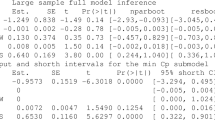Abstract
The solution to a Liapunov matrix equation (LME) has been proposed to estimate the parameters of the demand equations derived from the Translog, the Almost Ideal Demand System and the Rotterdam demand models. When compared to traditional scemingly unrelated regression (SUR) methods the LME approach saves both computer time and space, and it provides parameter estimates that are less likely to suffer from round-off error. However, the LME method is difficult to implement without the use of specially written computer programs and, unlike traditional SUR methods, it does not automatically provide an estimate of the covariance of the parameters. This paper solves these two problems, the first by providing a simplified solution to the Liapunov matrix equation which can be written in a few lines of code in computer languages such as SAS PROC MATRIX/IMLTM or GAUSSTM; the second, by bootstrapping the parameter covariance matrix.
Similar content being viewed by others
References
Anderson, R. G. and J. Thursby (1986) Confidence intervals for elasticity estimators.Review of Economics and Statistics,68, 647–656.
Bartels, R. H. and G. W. Stewart (1972) Algorithm #432 solution of the matrixAX+XB=C.Communications of ACM,15, 820–826.
Berndt, E. R. and D. Wood (1975) Technology, prices and the derived demand for energy.Review of Economics and Statistics,57, 259–268.
Blackorby, C. and R. R. Russell (1989) Will the real elasticity of substitution please stand up?American Economic Review,79, 882–888.
Bowden, R. J. (1973) Note on coefficient restrictions in estimating sets of demand relations.Econometrica,41, 572–579.
Byron, R. P. (1982) A note on the estimation of symmetric systems.Econometrica,50, 1573–1575.
Christensen, L. R., D. W. Jorgensen and L. J. Lau (1973) Conjugate duality and the transcendental logarithmic function.Econometrica,39, 355–256.
Deaton, A. and J. Muellbauer (1980) An Almost Ideal Demand System.American Economic Review,70, 312–326.
Eakin, B. K., D. P. McMillen, and M. J. Buono (1990) Construction confidence intervals using the bootstrap: an application to a multi-product cost function.Review of Economics and Statistics,72, 339–344.
Eastwood, D. B. and T. Y. Sun (1987) Complete demand systems and policy analysis, inFood Demand Analysis, R. Raunikar and C.-L. Huang (eds), Iowa State Press, Ames.
Efron, B. (1982)The Jackknife, The Bootstrap and Other Resampling Plans, Society for Industrial and Applied Mathematics, Philadelphia.
Freedman, D. A. and S. C. Peters (1984a) Bootstrapping a regression equation: some empirical results.Journal of the American Statistical Association,79, 97–106.
Freedman, D. A. and S. C. Peters (1984b) Bootstrapping an econometric model: some empirical results.Journal of Business and Economic Statistics,2, 150–158.
Gallant, A. R. and R. W. Koenker (1984) Some welfare econometrics of peak-load pricing of electricity.Journal of Econometrics,26, 83–114.
Green, R., W. Hahn, and D. Rocke (1987) Standard errors for elasticities: a comparison of bootstrap and asymptotic standard errors.Journal of Business and Economic Statistics,5, 145–149.
Hall, P. (1986) On the bootstrap and confidence intervals.Annals of Statistics,16, 1431–1452.
Hayes, K. J., J. G. Hirschberg, and D. J. Slottje (1987) Computer algebra: symbolic and algebraic computation in economic/econometric applications.Advances in Econometrics,6, 51–89.
Krinsky, I. and A. L. Robb (1986) On approximating the statistical properties of elasticities.Review of Economics and Statistics,68, 715–719.
Theil, H. (1975)Theory and Measurement of Consumer Demand, North-Holland, Amsterdam.
Toevs, A. L. (1982) Approximate variance formula for the elasticities of substitution obtained from translog cost functions.Economics Letters,10, 107–133.
Thisted, R. A. (1988)Elements of Statistical Computing, Chapman and Hall, New York.
Zellner, A. (1962) An efficient method of estimating seemingly unrelated regressions and tests for aggregation bias.Journal of the American Statistical Association,57, 348–368.
Author information
Authors and Affiliations
Rights and permissions
About this article
Cite this article
Hirschberg, J.G. A computationally efficient method for bootstrapping systems of demand equations: A comparison to traditional techniques. Stat Comput 2, 19–24 (1992). https://doi.org/10.1007/BF01890545
Received:
Accepted:
Issue Date:
DOI: https://doi.org/10.1007/BF01890545




